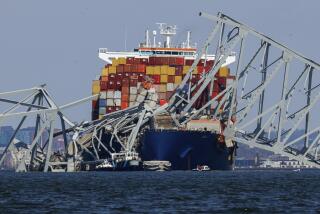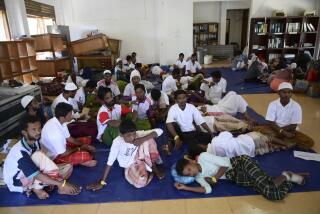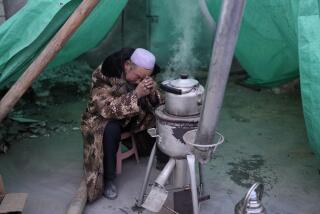Freak tornado hit ship on Yangtze, China officials say; death toll now 65
Among the hundreds of people anxiously waiting for word of their missing loved ones aboard a capsized Chinese cruise ship, Xuan Yan initially had perhaps a bit more reason to hope.
Many of the 458 people aboard the vessel were elderly sightseers on a budget 11-day Yangtze River trip. But her boyfriend, Chen Silu, was a spry 26-year-old tour company employee. Moreover, two of his colleagues were among the first survivors rescued after the ship abruptly sank Monday night in what officials said was an unusually powerful tornado.
“Your family, my family and I, and your good friends ... are all waiting for your news! Two of your colleagues were alive!” Xuan wrote on her microblog account Tuesday evening. “I know you must be very cold and hungry now. But you have to hold on for us!”
Xuan rushed to the site of the sinking, but found the area blocked off. Desperate for any shred of news, she posted her phone number online. “If anyone at the scene has confirmed information, please call my cell number. Thank you!”
But as Wednesday dawned with the ship still top-down in the river, Xuan’s frustration mounted. Not only was she not receiving updates, she even found herself barred from sending out messages -- censors apparently deemed her posts too sensitive and blocked them from appearing online.
“Right now, we’re just waiting for him,” she said in a brief phone conversation Wednesday afternoon as the tally of survivors -- 14 -- failed to budge from Tuesday’s count.
The death toll, on the other hand, continued to climb. Between 9 p.m Wednesday and 8 a.m. Thursday, according to state broadcaster CCTV, rescue workers recovered 39 bodies from the ship after cutting a hole in the hull. That drove the total confirmed dead to 65.
Officially, the operations at the site of the sinking of the Eastern Star remained an active rescue operation. But with more than 375 people still unaccounted for, hope was fading fast, and the incident appeared likely to become China’s worst maritime disaster in decades.
Government authorities were strictly controlling information about the disaster, ordering most domestic media outlets not to send their own reporters to the scene but instead rely on accounts from the state-run New China News Agency and CCTV.
But the Yangtze River Daily reported that a mortuary in Jianli, the county nearest to the accident site, was preparing a large number of coffins, and even CCTV broadcast live images of bodies being pulled from the water.
Throughout the day, authorities were struggling to decide whether the best approach was to attempt to right the ship or to lift it and cut into the hull in an effort to find anyone still alive in air pockets. After nightfall, officials said they had begun cutting a hole, approximately 21 inches by 24 inches, in the bottom of the 2,000-ton vessel to give divers access.
But any breach of the hull might cause trapped air to escape, causing the ship to lose buoyancy and sink deeper into the river.
Earlier, divers probing the hull for survivors reported encountering difficulties such as locked cabin doors and furniture blocking their way. Meanwhile, the search for people washed downstream was extended almost 140 miles to Wuhan, said Xu Chengguang, a Transport Ministry official.
As search, rescue and recovery operations continued, questions mounted over how and why the ship capsized suddenly Monday night. According to survivors, the vessel encountered strong rain and wind after 9 p.m.
Wu Cuihong, head of the weather bureau in Wuhan, said during a televised news conference that an unusually large and highly concentrated tornado about 0.6 miles in diameter developed right along the vessel’s path, lasting 15 or 20 minutes.
Li Yongjun, the captain of a freighter that was near the Eastern Star just before it capsized, told the New China News Agency that the weather was so severe he decided to anchor and wait out the storm.
“The visibility was terrible, like being in fog,” he said. “The rain was interfering with the radar so you couldn’t make anything out.”
Why the captain of the Eastern Star did not take similar action remained unclear. He and the ship’s chief engineer were among the 14 survivors and remain in police custody.
Zhong Shoudao of the Chongqing Shipbuilding Design and Research Institute said vessels such as the Eastern Star are “B-class” boats designed for river travel, not open ocean, and conceivably might be unable to withstand the winds generated by a tornado.
In such an event, the captain would not have time to organize an orderly evacuation, Zhong said at the news conference with Xu and Wu. “It’s not like ‘Titanic,’” where the ship’s hull was breached and began to take on water and slowly sink, Zhong said.
But other experienced seamen expressed skepticism that even a freak twister like the one Wu described could topple a ship like the Eastern Star in a matter of minutes.
“It’s almost impossible for wind to force a ship of this size to capsize, assuming [the boat] meets all legal standards,” Xue Yingchun, a ship captain from Shanghai with 23 years of experience, said in a phone interview. “In the open sea, storms can generate high waves, but the Yangtze is not very wide and a sudden storm would not make very large waves.”
Xue also said a sudden shifting of weight was also an unlikely scenario because the Eastern Star was a cruise ship and not a ferry with automobiles or other bulky cargo aboard.
Investigators, he believed, needed to focus on whether renovations had made the ship heavier or affected its balance, and whether the 1994 ship had been properly maintained.
“As a person in the industry, we’re all shocked and saddened by the large number of lives lost,” he said. “It’s very important to find out the cause so we can avoid this in the future.”
Authorities, he added, should not hesitate to call in outside experts from Germany, the U.S., or other countries with strong experience in river maritime safety.
“If we find our national standards are too low, perhaps we can improve them, or if it’s a matter of enforcement and closing loopholes, we need to reflect on that too,” he said.
Tommy Yang and Harvard Zhang in The Times’ Beijing bureau contributed to this report.
Follow @JulieMakLAT for news from China.
More to Read
Start your day right
Sign up for Essential California for news, features and recommendations from the L.A. Times and beyond in your inbox six days a week.
You may occasionally receive promotional content from the Los Angeles Times.







